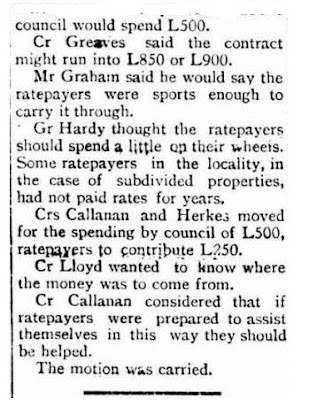From an occasional Correspondent.
"Vare iz de downsheep" The interrogator was a foreigner, and the person questioned was, Mr. Barrow, the local storekeeper of the "rising" township of Bunyip. For Bunyip, by the way, is at present only a small hamlet; in fact it is able to do very little more than 'claim to have, a ''local habitation" as well as a name. Nevertheless it has two hotels, well conducted by Messrs. Hanson and Finch. These two hostelries, with Mr. Barrow's general store, amicably uniting themselves pretty well form the township. There are also one or two unpretentious dwelling houses about, and a State School, of which Mrs. Skinner is the tutelary genius, lies back a little out of sight.
But still Bunyip may be designated as a rising township, for it stands prominently upon a steep "rise" overlooking the great Koo-wee-rup Swamp. To the foreigner's enquiry, "vare iz do downsheep," the interrogated resident replied with a majestic and comprehensive sweep of the hand, which took in the whole of the vast municipal settlement, "it is here." The foreigner looked puzzled and gazed earnestly round the whole sweep of the horizon, and then a bright idea penetrated his befogged intellect. "Oh! over de hill" he said, and was about to rush on thitherward to seek the goal of which he was in quest; but he was intercepted in his intention by the resident, who rejoined-"No; here. This is the township. Circumspice!" It was calculated to wound the civic patriotism to have thus with minute emphasis pointed out the locality in which one lives, but there is nothing for it but to remit it to the category of "another injustice to poor old Ireland," and Bunyip must bear its trials with what heroic fortitude it can.
I don't have any photos of Bunyip from 1887, but this is the Gippsland Hotel (Top Pub) and Main Street in 1908.
Photograph from The Call of the Bunyip by Denise Nest.
And this enhancement of the beauties of the locality should not be hidden in the very far distant future, and that some are far-seeing enough to perceive that this is evident from the fact that at a recent sale of Bunyip land lots at the outside boundary of the suburban area realised as much as £6 per acre. During his election tour Dr. L. L. Smith pledged himself to get the reclamation of the Koo-wee-rup Swamp entered upon as one of his first Parliamentary works, but the hon. gentleman substituted a trip to England, and since his return has forgotten to redeem his promise. But the work is one which must inevitably be undertaken before very long, for such a splendid tract of richly fertile country cannot long be allowed to lie waste within so short a distance of the metropolis. Here is a direction, Mr.Editor, in which your pen, so long wielded in advocacy of the interests of this district, might usefully be exercised. Meanwhile Bunyip is dependent for its existence upon the firewood trade. In a small place like this little can be expected in the way of social news. The arrival and departure of mails and trains constitute the excitements of the place.








